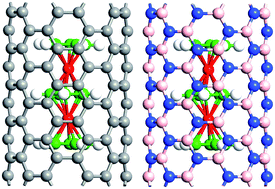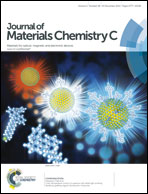Electronic and transport properties of carbon and boron-nitride ferrocene nanopeapods
Abstract
Electronic and transport properties of novel ferrocene based carbon nanotube (CNT) and boron-nitride nanotube (BNNT) nanopeapods, including Fe(Cp)2@CNT, Fe2(Cp)3@CNT, Fe(Cp)2@BNNT, and Fe2(Cp)3@BNNT (where Cp refers as cyclopentadiene), are investigated using the density functional theory and non-equilibrium Green's function methods. Computed electronic structures of the Fe(Cp)2@CNT and Fe2(Cp)3@CNT nanopeapods suggest that their electric conductivity is primarily contributed by the CNT π channel while the electron hopping from the core Fe(Cp)2 or Fe2(Cp)3 to the sheath CNT may have some contribution to the transport properties. Encapsulating Fe(Cp)2 into BNNT is more favorable for the electron conduction, owing to the splitting of the BNNT bandgap by the Fe(Cp)2 state. In contrast, introducing Fe2(Cp)3 into the BNNT is not beneficial to the conduction due to intramolecular electron transfer within the core Fe2(Cp)3 which can cause a trap effect. Because the transport channels can be changed by the applied bias voltage, the transport properties cannot be solely predicted from the electronic structures of infinite systems alone. For computing transport properties, we use two-probe device model systems with a finite-sized nanopeapod sandwiched between two CNT electrodes. Again, we find that encapsulating either Fe(Cp)2 or Fe2(Cp)3 into CNTs has little effect on the conductivity owing to the strong metallic character of the CNT sheath. Encapsulating Fe(Cp)2 into BNNTs can notably enhance electron conducting due to electron hopping from the core Fe(Cp)2 to the sheath BNNT. Encapsulating Fe2(Cp)3 into BNNTs, however, has little effect on the electron conductivity of BNNT nanopeapods due to the trap effect of the longer guest molecules. Hence, the length of guest molecules can effectively tune electronic and transport properties of the BNNT nanopeapods.


 Please wait while we load your content...
Please wait while we load your content...